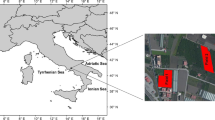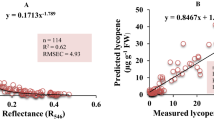Abstract
Tomatoes and tomato-related products are associated with many health benefits and disease risk reduction. This work was to explore the use of a miniaturized Raman spectroscopic system for rapid and nondestructive quality assessment of intact tomatoes. Combined with colorimetry and spectrophotometry methods, surface color and lycopene content of intact tomatoes were measured as references. The ratio of two chromaticity indices a*/b* of tomato surface increased when their freshness declined; the correlation coefficient (r) of the second-order polynomial curve-fitting was 0.908. The freshness discriminant model developed on Raman spectra gave a correctness of 85.6 %. The quantitative models performed poorly for predicting lycopene content based on Raman spectra. From the results obtained, it can be concluded that the established miniaturized Raman spectroscopic system was feasible for assessing the freshness of intact tomatoes. However, it is difficult to predict the lycopene content accurately.




Similar content being viewed by others
References
Agarwal A, Prahakaran SA, Said TM (2005) Prevention of oxidative stress injury to sperm. J Androl 26(6):654–660
Baranska M, Schutze W, Schulz H (2006) Determination of lycopene and β-carotene content in tomato fruits and related products: comparison of FT-Raman, ATR-IR, and NIR spectroscopy. Anal Chem 78:8456–8461
Baranski R, Baranska M, Schulz H (2005) Changes in carotenoid content and distribution in living plant tissue can be observed and mapped in situ using NIR-FT-Raman spectroscopy. Planta 222:448–457
Barba AIO, Hurtado MC, Mata MCS, Ruiz FV, de Tejada MLS (2006) Application of a UV–vis detection-HPLC method for a rapid determination of lycopene and β-carotene in vegetables. Food Chem 95:328–336
Bicanic D, Dimitrovski D, Luterotti S, Marković K, Twisk C, Buijnsters JG, Dóka O (2010) Correlation of trans-lycopene measurements by the HPLC method with the optothermal and photoacoustic signals and the color readings of fresh tomato homogenates. Food Biophys 5:24–33
Brereton RG (2003) Chemometrics: data analysis for the laboratory and chemical plant. Wiley, Chichester
Bunghez IR, Raduly M, Doncea S, Aksahin I, Ion RM (2011) Lycopene determination in tomatoes by different spectral techniques (UV–VIS, FT-IR and HPLC). D J Nanomater Bios 6(3):1349–1356
Camelo AFL, Gomez PA (2004) Comparison of color indexes for tomato ripening. Hortic Bras 22(3):534–537
Davis AR, Fish AR, Perkins-Veazie P (2003) A rapid spectrophotometric method for analyzing lycopene content in tomato and tomato products. Postharvest Biol Technol 28(3):425–430
Eleonora P, Algar WR, Medintz IL (2013) Quantum dots in bioanalysis: a review of applications across various platforms for fluorescence spectroscopy and imaging. Appl Spectrosc 67(3):215–252
Gill D, Kilponen R G, Rimai L (1970) Resonance Raman scattering of laser radiation by vibrational modes of carotenoid pigment molecules in intact plant tissues. Nature 227(5259):743–744
Hibbert DB, Gooding JJ (2006) Data analysis for chemistry-an introductory guide for students and laboratory scientists. Oxford University Press, Inc., New York
Hoskins LC (1984) Resonance Raman spectroscopy of β-carotene and lycopene. J Chem Educ 61(5):460–462
Køcks M, Banke SO, Madsen B, Vaz T, Carvalheira M, Pandega N, Sousa I, Nygaard SD (2013) Real-time monitoring of lycopene content in tomato-derived products during processing: implementation of novel double-slit Raman spectrometer. Appl Spectrosc 67(6):681–687
Lieber CA, Mahadevan-Jansen A (2003) Automated method for subtraction of fluorescence from biological Raman spectra. Appl Spectrosc 57(11):1363–1367
Liu X, Jiang L, Chen X (2012) Extraction of lycopene with organic solvent. Food Sci Technol 39(9):234–236
Luterotti S, Markovic K, Frank M, Bicanic D, Madzgalj A, Kljak K (2013) Comparison of spectrophotometric and HPLC methods for determination of carotenoids in foods. Food Chem 140(1–2):390–397
Nikbakht AM, Hashjin TT, Malekfar R, Gobadian B (2011) Nondestructive determination of tomato fruit quality parameters using Raman spectroscopy. J Agric Sci Technol 13:517–526
Oliveira VE, Castro HV, Edwards HGM, Oliveira LFC (2010) Carotenes and carotenoids in natural biological samples: a Raman spectroscopic analysis. J Raman Spectrosc 41:642–650
Pudney PDA, Gambelli L, Gidley MJ (2011) Confocal Raman microspectroscopic study of the molecular status of carotenoids in tomato fruits and foods. Appl Spectrosc 65(2):127–134
Qin J, Chao K, Kim MS (2010) Raman chemical imaging system for food safety and quality inspection. Trans ASABE 53:1873–1882
Qin J, Chao K, Kim MS (2011) Investigation of Raman chemical imaging of detection of lycopene changes in tomatoes during postharvest ripening. J Food Eng 107:277–288
Qin J, Chao K, Kim MS (2012) Nondestructive evaluation of internal maturity of tomatoes using spatially offset Raman spectroscopy. Postharvest Biol Technol 71:21–31
Rao AV, Agarwal S (2000) Role of antioxidant lycopene in cancer and heart disease. J Am Coll Nutr 19(5):563–569
Ravelo-Pérez LM, Hernández-Borges J, Rodríguez-Delgado MÁ, Borges-Miquel T (2008) Spectrophotometric analysis of lycopene in tomatoes and watermelons: a practical class. Chem Educ 13:11–13
Rimai L, Kilponen RG, Gill D (1970) Excitation profiles of laser Raman spectra in the resonance region of two carotenoid pigments in solution. J Am Chem Soc 92(12):3824–3825
Schaeberle MD, Morris HR, Turner JF, Treado PJ (1999) Raman chemical imaging spectroscopy. Anal Chem News Features 1:175–181
Schmitt S, Garrigues S, de la Guardia M (2014) Determination of the mineral composition of foods by infrared spectroscopy: a review of a green alternative. Crit Rev Anal Chem 44(2):186–197
Schulz H, Baranska M, Baranski R (2005) Potential of NIR-FT-Raman spectroscopy in natural carotenoid analysis. Biopolymers 77:212–221
Shi J, Maguer ML (2000) Lycopene in tomatoes: chemical and physical properties affected by food processing. Crit Rev Food Sci Nutr 40(1):1–42
Withnall R, Chowdhry BZ, Silver J, Edwards HGM, de Oliveira LFC (2003) Raman spectra of carotenoids in natural products. Spectrochim Acta A Mol Biomol Spectrosc 59(10):2207–2212
Xie L, Yao Y, Ying Y (2014) The application of terahertz spectroscopy to protein detection: a review. Appl Spectrosc Rev 49(6):448–461
Yang D, Ying Y (2011) Applications of Raman spectroscopy in agricultural products and food analysis: a review. Appl Spectrosc Rev 46:539–560
Acknowledgments
The authors appreciate the financial support from the National Natural Science Fund of China (31401289), the Research Fund for the Doctoral Program of Higher Education of China (No. 20110101120079), and the Education Department of Zhejiang Province (Y201122219).
Author information
Authors and Affiliations
Corresponding author
Ethics declarations
Conflict of Interest
Xiaping Fu declares that he has no conflict of interest. Xueming He declares that she has no conflict of interest. Huirong Xu declares that he has no conflict of interest. Yibin Ying declares that he has no conflict of interest.
Ethical Approval
This article does not contain any studies with human or animal subjects.
Informed Consent
Not applicable
Rights and permissions
About this article
Cite this article
Fu, X., He, X., Xu, H. et al. Nondestructive and Rapid Assessment of Intact Tomato Freshness and Lycopene Content Based on a Miniaturized Raman Spectroscopic System and Colorimetry. Food Anal. Methods 9, 2501–2508 (2016). https://doi.org/10.1007/s12161-016-0440-7
Received:
Accepted:
Published:
Issue Date:
DOI: https://doi.org/10.1007/s12161-016-0440-7




